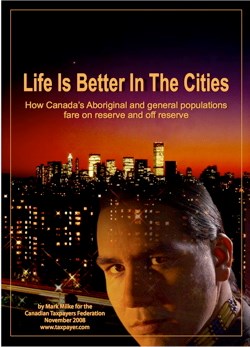NEWS RELEASE
CANADIAN TAXPAYERS FEDERATION
************************* Life is better in the cities
CTF releases new study on economic indicators on-reserve and off-reserve
CALGARY/WINNIPEG (November 6) - The Canadian Taxpayers Federation (CTF) today released a study on Canada's First Nations reserves and how Aboriginals fare on-reserve, off-reserve and [in] comparisons with Canadian averages.
The study, drawn from 2006 census data, summarized statistics and conditions across Canada and also compared 10 First Nation reserves to towns or cities within the same province, including comparisons in British Columbia, Alberta, Saskatchewan, Manitoba, Ontario, Quebec, New Brunswick and Nova Scotia. Mark Milke, a former director with the CTF and now the research director for the Frontier Centre, prepared the study for the Canadian Taxpayers Federation.
"The 2006 census data confirms what many people suspect, that life is often better for Aboriginals in the cities than on reserves," noted Milke. "However, and happily, there are exceptions, including the reserves run by the Osoyoos Indian Band and by the Westbank First Nation, both in southern British Columbia. There, economic indicators are roughly comparable to off-reserve statistics." The study found the following:
Only 26 percent of Aboriginals live on reserves
- Out of almost 1.2 million people who claim some sort of Aboriginal identity, 26.3 percent live on a reserve while 73.7 percent do not.
The majority of First Nations people do not live on reserves
- The category of Aboriginals most likely to live on a reserve is North American Indians (the term Statistics Canada uses for First Nation peoples). However, out of almost 700,000 North American Indians identified by the 2006 census, just over 300,000, or 43.1 percent, live on a reserve. Thus, the majority of self-identified North American Indians (56.9 percent) do not live on reserves.
For those who reside on reserves, 2006 census data reveal continuing poor socio-economic results
- For those who live on reserves, economic and social indicators consistently rank below those of Aboriginals in urban (non-reserve) communities and of non-Aboriginal Canadians. In general, Aboriginals on reserve fare the worst, Aboriginals off-reserve fare better, and the general population (also off-reserve) fare the best
- For example, for North American Indians (the census category used by Statistics Canada for First Nations and the group which makes up 87.7 percent of the population on reserves) median earnings were $29,014 on-reserve compared to $37,447 off-reserve
- On educational achievement, 49.6 percent of registered Indians have no university degree, trade certificate or even a high school diploma. The percentage for the general population is 23.3 percent.
In most cases, median earnings are lower and unemployment rates are highest on reserves compared to Canadian urban centres and also when compared to Aboriginals living in Canadian towns and cities.
For example:
- Aboriginals living on the Stoney First Nation reserve near Calgary have a participation rate of 64.1 percent, an unemployment rate of 37.7 percent and median earnings for full-time, full-year work of $21,265. Aboriginals living in Calgary have a participation rate of 77.2 percent and an unemployment rate of 7.3 percent and median earnings for full-time, full-year work of $38,094. The figures for the Calgary population show a participation rate of 75.6 percent an unemployment rate of 4 percent and median earnings for full-time, full-year work of $46,189. - Aboriginals living on the Peguis reserve, Manitoba's largest reserve, approximately 145 kilometres from Winnipeg, have a participation rate of 49.3 percent, an unemployment rate of 30.2 percent and median earnings for full-time, full-year work of $29,989. Aboriginals living in Winnipeg have a participation rate of 58.1 percent, an unemployment rate of 11.3 percent and display a median earnings for full-time, full-year work of $33,362. The figures for the Winnipeg population show a participation rate of 67.3 percent an unemployment rate of 5.5 percent and median earnings for full-time, full-year work of $38,773.
Happy exceptions: Osoyoos and Westbank reserves However, there are laudable exceptions and examples of reserves in Canada that have defied the statistical stereotype and succeeded.
- The Osoyoos Indian Band in southern British Columbia (known for its very successful NK'MIP winery) have a participation rate of 68.6 percent, an unemployment rate of 14.3 percent and median earnings for full-time, full-year work of $26,944. In comparison, Aboriginals who live in the south Okanagan city of Penticton have a participation rate of 65.8 percent, an unemployment rate of 9.4 percent and median earnings for full-time, full-year work of $30,028. The figures for the Penticton population show a participation rate of 57.4 percent, an unemployment rate of 6.5 percent and median earnings for full-time, full-year work of $36,369
- Similarly, the Westbank First Nations reserve near Kelowna shows a participation rate of 71.3 percent, an unemployment rate of 8.5 percent and median earnings for full-time, full-year work of $31,810. In comparison, Aboriginals who live in Kelowna have a participation rate of 71.1 percent, an unemployment rate of 8 percent and median earnings for full-time, full-year work of $31,174. The figures for the Kelowna population show a participation rate of 64 percent, an unemployment rate of 5.1 per4cent and median earnings for full-time, full-year work of $38,832.
CTF-Manitoba Director Colin Craig noted that: "The CTF has long been an advocate of substantial Aboriginal policy reform. This paper builds the case for phasing out the Indian Act, eliminating reserves, extending private property rights to Aboriginal people and transferring government assistance directly to reserve members and not band politicians." A copy of the study Life is Better in the Cities: How Canada's Aboriginal Population Fares On-Reserve and Off-Reserve, can be found here.
*************************
